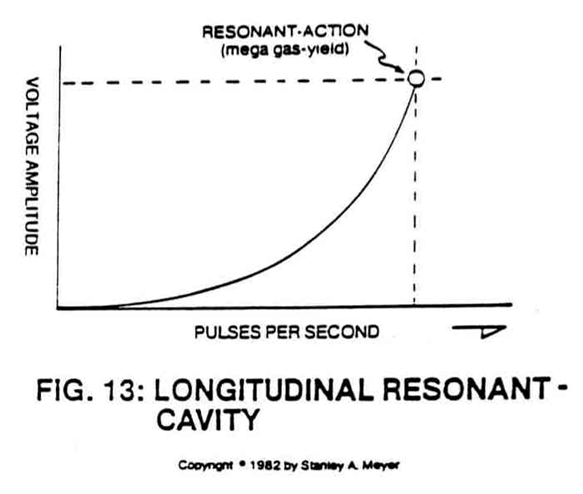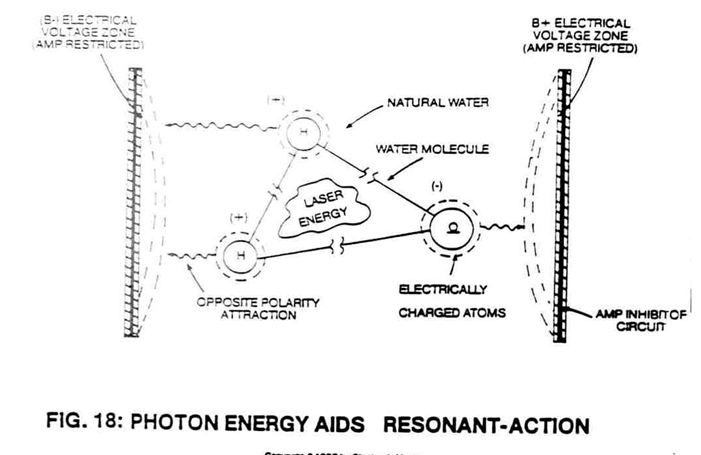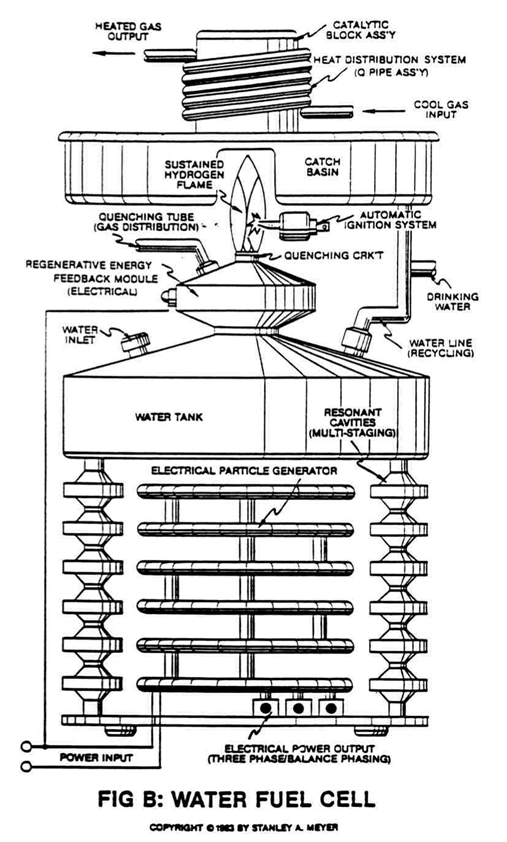Mega Watt Gas Yield
The previous method of producing hydrogen gas via the application of voltage potential (pressure or force within an electrical system) is quite efficient, but there are several advance steps to the ELECTRICAL POLARIZATION PROCESS that increase hydrogen gas energy production astronomically from natural water.
This is simply done through the use of a Resonant Cavity Fuel Cell, as so illustrated in Figures 12, 17, 19 and 20.
 |
 |
RESONANT ACTION AND THE PHENOMENA:
The Resonant Action (as graphically depicted) within the Fuel Cell occurs in a systematic way.
First an oscillating voltage field, or zone, is formed around a second oscillating voltage field, or zone, opposite in electrical polarity and forming a water zone in between.
The two oscillating voltage zones are synchronized into a single repetitive wave form as shown in Figures 9A, 9B and 16.
 |
As the water molecules are exposed to the reforming voltage zones, the hydrogen atoms become positive electrically charged while the oxygen atom becomes negative electrically charged...electrically polarizing the water molecule, as illustrated in Figures 2 and 3.
The pulsating voltage zones also help restrict amp flow during the electrical polarization process.
Once the electrical polarization phenomenon occurs, the covalent bonding, or sharing, of electrons between atoms of the water molecule ceases to exist since the positive electrically charged hydrogen atoms attract the free floating negative charged electrons while, at the same time the negative electrically charged oxygen atom repels the moving electrons...
- thereby stabilizing the energy levels of the atoms...
- separating the water molecule into its component parts...
- releasing energy in the form of hydrogen gas and oxygen gas, as illustrated in Figure 3.
The opposite polarity attraction that now exists between the liberated electrically charged atoms and the stationary electrical voltage zones further aids the splitting process by imparting a physical impact (particle impact) on neighboring molecules undergoing the electrical polarization process.
Since the voltage zone that forms the resonant cavity outer wall momentarily entraps the liberated atoms, the moving atoms are accelerated and deflected among other molecules being split...causing compound action, as so illustrated in Figures 13, 14 and 15.
 |
 |
This compounding action continues to increase as more atoms are being liberated from other water molecules.
The repetitive pulse voltage frequency potential continues the compounding action, whereas an increase in voltage amplitude speeds up the compounding action under controlled means.
Simply moving liberated atoms back and forth uniformly through the electrical polarization process in a repetitive manner establishes Resonant Action within the Fuel Cell.
RESONANT ACTION ENHANCEMENT:
 Resonant Action enhancement beyond the influence of pulse voltage potential is accomplished in several ways. In the area of electron deflection, the electrically charged atoms moving toward the water molecules further disrupt the covalent bonding, while at the same time increasing the electrical charges inside the Fuel Cell during the electrical polarization process.
Resonant Action enhancement beyond the influence of pulse voltage potential is accomplished in several ways. In the area of electron deflection, the electrically charged atoms moving toward the water molecules further disrupt the covalent bonding, while at the same time increasing the electrical charges inside the Fuel Cell during the electrical polarization process.
Increasing the number of electrically charged atoms within the Fuel Cell directly increases the voltage charges within the same cell while applied pulse voltage frequency potential remains the same...increasing gas yield while power input remains constant.
In terms of design application, the resonant cavity is multi-tier with other resonant cavities of similar design in a sequential manner, as shown in Figures 20D, 20H, and Figure B.
As the electrical polarization process occurs, the liberated and electrically charged atoms are recycled inside the resonant cavity prior to atom injection into the next cavity-structure undergoing the same recycling process.
The orderly and sequential progression of the moving charged atoms through the cavity-array increases the voltage charges per stage since more atoms are being allowed to interact with each proceeding stage.
To increase gas yield even further, additional atom recycling cavities are affixed to the vertical array to meet a predetermined gas need.
The interaction of the laser beam or light energy (see Figure 20D) with the liberated atoms inside the resonant cavity during the electrical polarization process causes the free floating atoms to either lose or gain electrons...causing said atoms to become electrically charged and used as herein described.
The expelling charged atoms of Figure 20D are used in conjunction with the electrical polarization generator of Figure 40 to form the regenerative energy feedback network of Figure A as pictorially illustrated in Figure B.
This process simply uses the component parts of water to produce electricity without consuming the charged atoms prior to gas ignition.
 |
 |
ATOM INJECTED RESONANT ACTION: THE ROCKET ENGINE:
To capitalize on this electrical charge phenomena still further, the atom-injected resonant cavity of Figure 20 was developed.
The atom guns are smaller resonant cavities that liberate and expand electrically charged hydrogen and oxygen atoms into accelerator tubes for particle acceleration.
Once accelerated to maximum speed, the projected electrically charged atoms are injected into a larger resonant cavity...providing particle impact…supercharging the electrical field inside the central fuel cell for even higher gas yield.
This electrical charging process is ideal since natural water is the prime source for the electrically charged atoms.
This process is further exemplified in the vertical-array fuel cell of Figure 20H and power loading circuit of Figure 20D.
 |
 |
Note how the high voltage pulse is sequentially sync with the pulsing laser during each cavity stage.
LASER INJECTED RESONANT ACTION: THE THROTTLE BOOSTER:
Since laser or light energy is electromagnetic energy having zero mass and no electric charge, particle impact within said resonant cavities is accomplished by ionizing the atoms of said water molecule.
As the laser energy is superimposed onto the electrical polarization process, as shown in Figure 18 and 19, the photon or light energy (see Figure 19A) is being absorbed by the water molecule atom(s) nuclei.
 |
 |
Once the electrical polarization process occurs, many liberated atoms (including ambient air gases) become positive electrically charged when said atoms lose an electron, forming a positive charged ion.
The electromagnetically primed (atom absorbing light energy) hydrogen atom may now accept said liberated electron, forming a negatively charged ion.
By simply attenuating said high intensity voltage pulse, said charged atoms are set into motion…causing particle impact or particular collision during the electrical polarization process.
The liberated negatively charged electrons are also set into motion to help aid or boost said particular impact.
The uniform movement (particular oscillation) of said electrically charged particles within said resonant cavity is now called compounding-action or resonant-action.
Hydrogen Gas Gun Technology:
To sustain energy-yield beyond the gas-flame combustion state sustaining and maintaining a hydrogen/oxygen flame), the Electrically charged (atom having missing or more than normal amount of electrons) and "Optically Primed" (atoms absorbing photon energy) combustible gas ions being expelled from Resonant Cavity Array (Figure 20D) now enters into and through a Hydrogen Gas Gun Assembly placed on top of and interlocked with said Resonant Cavity Assembly, as illustrate in Figure 20H.
 |
 |
The moving combustible gas ions are subjected to higher energy levels (Voltage and Laser Stimulation) while being exposed to an Electron Extraction Process for the purpose of further destabilizing the mass/electrical equilibrium of said gas atoms.
The Voltage intensifier Circuit simply prevents electron replacement during voltage stimulation.
 The specially treated combustible gas ions are now subjected to thermal stimulation via an Optical Thermal Lens Assembly...forcing said Electrically Charged and Laser Primed combustible gas ions to reach critical state...
The specially treated combustible gas ions are now subjected to thermal stimulation via an Optical Thermal Lens Assembly...forcing said Electrically Charged and Laser Primed combustible gas ions to reach critical state...
causing said gas ions to decay...releasing thermal explosive energy beyond the gas flame stage.
The point of atomic energy-yield is simply reached when the electron deficient oxygen atom (having less than normal amount of electrons) locks onto and captures the hydrogen atom electrons prior to and during thermal-combustion stimulation.
The thermal explosive energy-yield is known as the "Hydrogen Fracturing Process."
Together, the Optical Thermal Lens Nozzle, the Hydrogen Gas Gun, and Resonant Cavity Assembly forms a design variable Water Fuel Cell that is cost effective as to retrofit energy systems.









